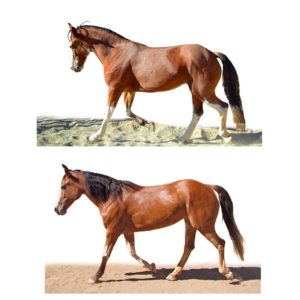Ever watch your horse out in the field carrying their head so beautifully, completely on their own? Then you just wonder, “How come they don’t do that when I ride them?”
Well, with some patience you can get that pretty headset without restraints, so you know that you’re not pressuring your horse into something that hurts. (Please note, a nice tucked head does NOT equal collection, not at all. However it does help you encourage your horse to collect, and travel more “round” which is definitely a good thing! Roundness means the horse is engaging their hind end even just a little bit, so in order for that nice framed look you need to encourage those hindquarters first. Otherwise, all you’ll have is the artificially framed, hollowed-back horse.) Using this activity, your horse can learn to stretch downwards as well as tuck in their chins a little bit, which can translate to movement. Downwards stretching is very good for their whole bodies! You might even try stretching their necks down and to the side, both directions as a warm up routine. The possibilities are endless! Asking for the horse to arch their neck for you really helps turn their focus inwards, and helps keep that engaging conversation between horse and human.
Developing the muscle and coordination to hold the frame is smart for your horse’s health, as it gives them the opportunity to learn it at the standstill, walk, trot, etc. without having to carry a rider. When practiced at liberty, you allow your horse to develop this ability at their own rate, instead of risking accidentally forcing it out of them too early.
How to Start
First, just feed your horse a treat by holding your hand just a little further beneath their head than normal. This will help set them up for success. Next, hold the treat a bit further and add your chosen cue. Rachel’s verbal cue is “Face” and Lauren’s is “Head”, you can also try something such as pointing to the chest. Alternatively, you can teach your horse to target an object first, then have them simply target the object when holding it under their chin. The targeting method is definitely the way to go if you have a grabby horse! Don’t lose any fingers over this, please. As always, gradually increase the distance they have to reach. At first click first for every little try and then only every time they get a bit closer to the goal. Soon you will not have to “bribe” them at all with the treat or target, but rather just say the verbal or physical cue.
How high or low should their head be when they tuck their chin? That will change for each horse. Anatomically speaking, a collected horse’s poll would be the highest point of their body. This position also occurs when a horse is properly “on-the-bit” and in a working position. The poll can be observed as the point directly behind the ears, where your halter or bridle sits. For trick and stretching purposes, you can ask for them to bend lower, but keep in mind when they start moving forward it is a good thing that they want to carry their heads a little bit higher or lower! The more technical way of looking at it is “behind-the-vertical”, you want your horse to travel in front of the vertical or rather, their eye to be in line or behind the nostril. If you’re not doing it for riding, but rather just as a bonding exercise to increase focus, none of this vertical talk applies to you 🙂
At this point, you can easily transfer the cue to a neckrope or other tool you use for riding. Simply apply the new cue while simultaneously cueing with the learned cue. Most horses can pick this up very quickly. Once you get on and cue, it might be confusing for the horse at first. Sometimes it is easier to have someone on the ground to reinforce the cue. At this point, the clicker will be particularly useful at maintaining consistency and clarity for your horse!
The top picture here is from October 1, 2014, while the bottom one (which is flipped, hence the different markings) is from around the beginning of July, 2014 – 13 weeks ago. We have been working on holding the headset for longer periods of time, building up that neck muscle, as well as engaging the hind end through in-hand and mounted collection exercises. Notice that she now carries her body better, her hind is more muscled and engaged, her back is rounded, her head is maintained in this position at the trot, yet her tail remains relaxed and slightly lifted. Though it is still difficult for her to maintain this position while being ridden, muscle memory is a wonderful thing and these improvements will transfer over with time.
But what if I ride with a bridle?
Even if you ride in a bridle or halter and ask for your horse to go “on-the-bit” with pressure on the face, practicing the headset on the ground as a strengthening exercise will still benefit your horse. For horses that have naturally too high head carriage, this is a great, “natural” way to help encourage your horse to stretch down into that low, relaxed neck position. Instead of asking for your horse to just tuck their chin at their comfortable level, ask instead for them to reach down further to achieve a down and low position. This is great for all horses, and when achieved in motion will strengthen and stretch their back. You don’t want your horse to stretch down while tucking their chins in when moving, but it is fine while standing! Remember the goal of not ending up “behind-the-vertical”.

